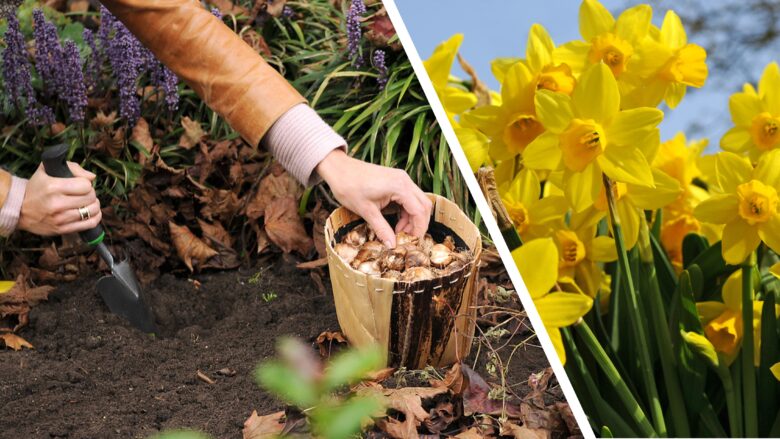Welcome to the world of daffodils – the quintessential flowers of spring that bring vibrant color and a sweet fragrance to any garden. As winter fades and the days get longer, the sight of these blooming beauties signals the arrival of spring. Are you looking to cultivate daffodils in your own garden but not sure where to begin? Look no further! This article has everything you need to know to create a stunning daffodil display that will leave you in awe.
What Are Daffodils?
Daffodils are a type of flowering plant that falls under the Narcissus genus. These perennial bulbs typically bloom in the spring, adding a burst of vibrant colors to gardens and landscapes. Known for their trumpet-shaped flowers, daffodils can be found in a range of colors such as yellow, white, and orange. They are fairly easy to grow, requiring well-drained soil and plenty of sunlight. One of their appealing qualities is their ability to naturalize and spread, making them a popular choice for gardens and landscapes. Additionally, daffodils are resistant to deer, making them a low-maintenance and visually stunning option for gardeners.
Why Should You Grow Daffodils?
There are several benefits and reasons why you should consider growing daffodils in your garden:
- Easy to Cultivate: Daffodils are low-maintenance plants that require minimal care and attention.
- Early Bloomers: These vibrant spring flowers are one of the first to bloom, adding a burst of color to your garden after a long winter.
- Symbol of Optimism: Daffodils are often seen as a symbol of hope and new beginnings, making them a perfect addition to any garden.
- Natural Pest Repellent: The bitter taste of daffodils deters pests like deer and rodents, protecting other plants in your garden.
- Long-Lasting Beauty: With a long flowering period, daffodils provide weeks of stunning blooms in your garden.
Daffodils have a rich history, having been cultivated for centuries. They were first mentioned in ancient Greek and Roman texts and were highly valued for their beauty. In the 17th century, daffodils gained popularity in Europe and became a common sight in gardens. Today, these charming flowers are still cherished and remain a beloved symbol of spring.
When and How to Plant Daffodils?
To successfully plant daffodils, follow these steps:
- Timing: Plant bulbs in the fall, about 2-4 weeks before the ground freezes.
- Location: Choose a sunny or partially shaded spot with well-draining soil.
- Preparation: Dig a hole that is three times deeper than the bulb’s height.
- Spacing: Space bulbs 4-6 inches apart, and plant them with the pointed end facing up.
- Covering: Backfill the hole with soil and gently press it down to remove air pockets.
- Watering: Give the newly planted bulbs a good watering to settle the soil.
- Maintenance: Mulch the area to protect the bulbs from extreme temperatures.
Daffodils have a rich history dating back to ancient Greece. They were cultivated by the Romans for their beauty and fragrance. In the 17th century, daffodils were brought to Europe and became popular ornamental plants. Today, daffodils are cherished for their vibrant colors and are a symbol of new beginnings and spring.
What Are the Best Growing Conditions for Daffodils?
Daffodils thrive in specific growing conditions that promote their vibrant blooms. These conditions include:
- Sunlight: It is best to plant daffodils in areas that receive full sun or partial shade.
- Soil: Well-drained soil is crucial to prevent bulb rot. Ideal soil types for daffodils include sandy or loamy soil with good organic matter content.
- pH Level: Daffodils prefer slightly acidic to neutral soil with a pH range of 6 to 7.
- Watering: Adequate moisture is necessary during the growing season, but be careful not to overwater as it can lead to bulb rot.
- Temperature: Daffodils can tolerate cold temperatures, but they also require a chilling period to bloom successfully.
- Planting Depth: To ensure healthy growth, plant daffodil bulbs at a depth of three times their diameter.
By providing these optimal growing conditions, you can enjoy beautiful and vibrant daffodil blooms in your garden.
How Deep Should You Plant Daffodil Bulbs?
When planting daffodil bulbs, it is crucial to consider the appropriate depth for optimal growth. Follow these steps to ensure proper planting for healthy daffodils:
- Choose a spot with well-drained soil and full sun.
- Dig a hole that is 2-3 times deeper than the height of the bulb.
- Place the bulb in the hole with the pointed end facing upwards.
- Cover the bulb with soil, making sure there is a 2-3 inch layer of soil above the top of the bulb.
- After planting, thoroughly water the area to settle the soil.
Remember, planting daffodil bulbs too shallow or too deep can impact their growth and blooming. It is always best to follow the specific instructions provided with your purchased bulbs. Happy planting!
Should You Fertilize Daffodils?
Is it Necessary to Fertilize Daffodils?
Fertilizing daffodils is not necessary, but it can enhance their growth and blooming. Daffodils are strong and can thrive even in poor soil conditions. However, if you want to promote healthier plants and more abundant flowers, it is recommended to apply a balanced fertilizer in early spring. To encourage flower formation, choose a fertilizer with a higher phosphorus content. Be sure to carefully follow the instructions to avoid overfertilization. Alternatively, organic options such as compost or well-rotted manure can also be used. Ultimately, the decision to fertilize daffodils should be based on the specific needs of your garden and your desired outcome.
How to Care for Daffodils?
To ensure a vibrant spring garden and proper care for daffodils, follow these steps:
- Planting: Choose a sunny location with well-draining soil. Dig a hole that is 6-8 inches deep and place the bulb with the pointed end facing up.
- Watering: Thoroughly water the newly planted bulbs, and then maintain moist soil without over-watering.
- Fertilizing: Apply a balanced fertilizer once the daffodils start to emerge in early spring.
- Pruning: After the flowers have faded, remove the spent blooms, but allow the foliage to remain until it turns yellow and naturally dies back.
- Dividing: Every 3-5 years, dig up overcrowded clumps and separate the bulbs, then replant them.
How Often Should You Water Daffodils?
To ensure healthy growth and vibrant blooms, daffodils need to be watered adequately. Follow this simple guide on how often you should water daffodils:
- During planting: After planting, make sure to water the bulbs thoroughly to settle the soil.
- Early growth: Daffodils should be watered regularly during their active growth period, especially if there is not enough rainfall.
- Established plants: As the foliage of the daffodils starts to yellow and die back, reduce watering.
- Dry spells: During extended dry periods, provide deep watering to keep the soil moist.
Pro-tip: Avoid overwatering daffodils as it can cause bulb rot. It is best to monitor the soil moisture and adjust watering accordingly.
When and How to Prune Daffodils?
Pruning daffodils is crucial for maintaining their health and promoting future growth. Follow these steps to properly prune your daffodils:
- Wait until the daffodil foliage turns yellow or brown after blooming.
- Using sharp and clean pruning shears, trim the foliage about 2-3 inches above the ground.
- Be careful not to trim the leaves too early, as they play a vital role in storing energy for the bulbs’ growth in the next season.
- Remove any dead or damaged leaves and flowers to prevent the spread of diseases.
- Dispose of the pruned foliage in the trash or compost, not in the garden.
By properly pruning your daffodils, you ensure their long-term vitality and encourage beautiful blooms in the following seasons.
How to Divide and Replant Daffodils?
To divide and replant daffodils, follow these steps:
- Choose the right time: The ideal time to divide and replant daffodils is during late summer or early fall, once the foliage has turned yellow.
- Prepare the soil: Choose a location with good drainage and full sun or partial shade. Loosen the soil and clear away any weeds or debris.
- Divide the bulbs: Gently lift the clumps of daffodils using a garden fork or shovel. Carefully separate the bulbs, making sure each division has its own set of roots.
- Replant the bulbs: Dig holes that are 2-3 times the height of the bulb. Place each bulb in the hole with the pointed end facing upwards and cover with soil, leaving the top of the bulb exposed.
- Water and mulch: Thoroughly water the newly planted bulbs and add a layer of mulch to retain moisture and prevent weed growth.
- Monitor and maintain: Regularly water the bulbs during dry periods and remove any weeds that may appear.
How to Prevent and Treat Pests and Diseases in Daffodils?
To effectively prevent and treat pests and diseases in daffodils, follow these steps:
- Start with healthy bulbs: It is important to begin with disease-free bulbs from a reputable source.
- Plant at the proper depth: To promote healthy growth and reduce the risk of disease, make sure to plant bulbs at the recommended depth.
- Ensure good drainage: Proper soil drainage is essential to prevent waterlogged conditions that can lead to fungal diseases.
- Avoid overwatering: Daffodils prefer well-drained soil, so it is important to water them sparingly to prevent root rot.
- Remove debris: Keep the planting area free of dead leaves and plant debris to eliminate hiding places for pests.
- Monitor for pests: Be on the lookout for pests such as slugs, snails, and aphids. If necessary, use organic pest control methods or insecticidal soaps.
- Rotate planting locations: To prevent the buildup of soil-borne diseases, avoid planting daffodils in the same spot each year.
- Use fungicides: If needed, apply fungicides to treat fungal infections like crown rot or bulb rot.
What Are Common Pests That Affect Daffodils?
Daffodils are often affected by common pests such as the narcissus bulb fly, bulb mites, and slugs. These pests can cause damage to the bulbs, stunted growth, and harm to the leaves and flowers. To prevent their presence, it is recommended to use insecticides, maintain good garden hygiene, and remove any infested bulbs. Planting daffodils in well-drained soil and avoiding overcrowding can also help deter these pests. Regular inspection and immediate action can effectively protect your daffodils from these troublesome pests.
What Are Common Diseases That Affect Daffodils?
Common diseases that affect daffodils include:
- Narcissus basal rot
- Gray mold
- Bulb scale mite infestation
These diseases can cause:
- Yellowing and rotting of the leaves and bulbs
- Browning and decay of the flowers and foliage
- Shriveled and distorted growth
To prevent these diseases, it is important to:
- Ensure proper drainage
- Avoid overwatering
- Plant daffodils in well-drained soil
If any plants do become infected, it is recommended to remove and destroy them in order to control the spread of diseases.
How to Use Daffodils in Your Garden and Home Decor?
To incorporate the requested keywords, here is a list of steps on how to use daffodils in your garden and home decor:
- In the garden, plant daffodils in clusters or rows for a vibrant display.
- Combine different varieties of daffodils to create a diverse and visually appealing garden.
- Use daffodils as borders or edging plants to define garden beds.
- For home decor, cut daffodils and arrange them in a vase to brighten up any room.
- Create a centerpiece using daffodils, greenery, and other spring flowers for a stunning table display.
- Place potted daffodils indoors near windows or on a porch to bring a touch of spring into your home.
- Consider drying daffodils to use in wreaths or floral arrangements for long-lasting decor.
What Are Some Creative Ways to Display Daffodils?
To creatively display daffodils, consider these ideas:
- Arrangement: Place daffodils in a bouquet or mix them with other spring flowers like tulips and hyacinths.
- Mason jars: Arrange daffodils in mason jars filled with water and tie a ribbon around the jar for a rustic touch.
- Floating centerpiece: Float daffodil blooms in a shallow bowl or vase filled with water for a unique centerpiece.
- Vintage containers: Display daffodils in vintage teacups, watering cans, or tin cans for a charming look.
- Hanging baskets: Plant daffodil bulbs in hanging baskets for an eye-catching display on your porch or patio.
Fact: Did you know that daffodils are one of the first flowers to bloom in spring, symbolizing new beginnings and hope?
How to Incorporate Daffodils into Your Landscape Design?
To successfully incorporate daffodils into your landscape design, follow these simple steps:
- Choose the perfect location: It is important to find an area with well-draining soil and ample sunlight for your daffodils to thrive.
- Prepare the soil: Make sure the soil is loose and fertile by adding organic matter before planting.
- Plan the layout: Decide on the desired arrangement and spacing of the daffodils in your landscape.
- Plant the bulbs: Dig holes at the appropriate depth, usually 2-3 times the height of the bulb, and carefully plant your daffodil bulbs.
- Water and mulch: After planting, water your daffodils thoroughly and apply a layer of mulch to help conserve moisture.
- Maintain: To ensure healthy growth, regularly water your daffodils during dry periods and remove faded flowers to encourage more blooms.
Consider incorporating daffodils in various areas such as rock gardens, borders, or naturalized areas in your landscape. For a stunning display, pair them with other early spring bloomers like tulips or hyacinths.
Can You Use Daffodils in Flower Arrangements?
Yes, daffodils can definitely be used in flower arrangements. These vibrant and uniquely shaped flowers are a popular choice for floral displays, adding a touch of elegance and freshness. They pair well with other spring flowers like tulips, hyacinths, and irises, making them a versatile option for any arrangement.
However, it’s important to be cautious when arranging daffodils as their sap can cause other flowers to wilt prematurely. To avoid this, it is recommended to condition daffodils separately by soaking their stems in water for a few hours before incorporating them into an arrangement with other flowers.
Frequently Asked Questions
How do I prepare my garden for planting daffodils?
Before planting daffodils, it is important to choose a location that receives at least 6 hours of sunlight per day and has well-draining soil. Once you have selected a spot, clear the area of any debris, weeds, or rocks and loosen the soil to a depth of 12-15 inches. Adding some compost or organic matter can also help improve the soil’s fertility and drainage.
When is the best time to plant daffodil bulbs?
The best time to plant daffodil bulbs is in the fall, typically between September and November. This allows the bulbs to establish strong root systems before the winter freeze. However, you can also plant them in early spring if the ground is not frozen and you are unable to plant them in the fall.
How deep should I plant my daffodil bulbs?
Daffodil bulbs should be planted at a depth of 4-6 inches, with the pointed end facing upwards. If you are planting multiple bulbs, make sure to space them at least 3-6 inches apart to allow for proper growth and air circulation.
Are daffodils suitable for container gardening?
Yes, daffodils can be grown in containers as long as the container is at least 12 inches deep and has drainage holes. Use a well-draining potting mix and plant the bulbs at the same depth as you would in the ground. Keep the containers in a location that receives 6-8 hours of sunlight per day and water them regularly.
How often should I fertilize my daffodils?
Daffodils do not require frequent fertilization, but it is recommended to fertilize them once a year in the fall when planting. Use a slow-release fertilizer or a balanced fertilizer with equal amounts of nitrogen, phosphorus, and potassium. Avoid fertilizing after the plant has started to flower, as this can cause the plant to produce more foliage and less blooms.
What should I do with my daffodils after they finish blooming?
After your daffodils have finished blooming, allow the foliage to die back naturally. This process is important as it helps the bulb store energy for the next year’s growth. Once the foliage turns yellow and withers, you can cut it back to ground level. Do not braid or tie the foliage, as this can prevent nutrients from reaching the bulb.



